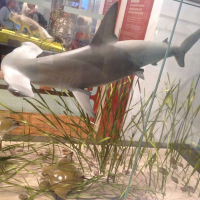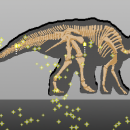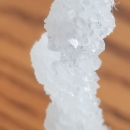Project: Big Shark, Big Loss, Big Impact: Sharks Change Prey Behaviour

Play this predator-prey simulation game with your students to discover how important sharks are in affecting the behaviour of other animals in their ecosystems.
Produced in partnership with the Biodiversity Education and Awareness Network and the Ontario Ministry of Natural Resources


Students are fascinated by dangerous sharks, but may not realize the key role they play in marine ecosystems. Large predatory fish populations have plummeted over 90% in the last decade. This decline has the potential for serious and cascading effects on Canada’s marine ecosystems. Through two simulation games, students will learn why apex predators are necessary for functioning ecosystems.
Learning Goals
- Analyse positive and negative impacts of humans hunting sharks within marine communities
- Describe energy transfer in a food chain and explain the effects of the elimination of apex predators
- Collect data by conducting an experiment to do with the environment and record observations
- Read, interpret, and draw conclusions from data presented in charts, tables, and graphs
Background Information
Canada’s three oceans, Atlantic, Pacific and Arctic, are home to 41 species of sharks including the Shortfin Mako, Greenland, Sleeper, Basking, Smooth Hammerhead, and even the Great white shark! Sharks often fill the role of “apex” or top predators in their ecosystems because of their large size and few natural predators. As apex predators, sharks feed on animals below them in the food web, and help regulate and maintain the balance of marine ecosystems. Most sharks have diverse diets and switch prey species when certain populations are low. By switching to more abundant prey, they allow low populations to rebound and prevent abundant species from monopolizing a limited resource. Others scavenge the sea floor to feed on dead carcasses. Apex predators also influence spatial distribution of prey species through intimidation and keep them from overgrazing certain habitats.
The unfortunate reality of course is that humans are the ocean’s true apex predators, killing more than 100 million sharks each year. Fishing has reduced many large predatory shark populations worldwide by 90% over the past century. Sharks now represent the largest group of threatened marine species on the International Union for Conservation of Nature’s (IUCN) Red List of threatened species, yet only three of the 350 shark species (Basking, Whale and White), are protected from the pressures of international trade. The remaining species are ignored or seen as low priorities despite their vulnerability to overfishing and their important role in their ecosystems. In Canada there are ten species of sharks designated at risk by the Committee on the Status of Endangered Wildlife in Canada (COSEWIC). These include White, Brown Cat, Tope, Bluntnose Sixgill, Blue, Basking, Porbeagle, Spiny dogfish, Shortfin Mako, and Spotted Spiny Dogfish.
Some fisheries directly target sharks as their intended catch, but other fisheries accidentally capture sharks as “bycatch”, a term used for unintended catch. These unwanted sharks are thrown overboard, often dead or injured. It is estimated that tens of millions of sharks are caught as bycatch each year, which is nearly half of the total shark catch worldwide.
Between 26 and 73 million sharks are killed annually for their fins globally (caught both specifically and as bycatch). Once a delicacy and sign of prestige in Asian cultures, shark fin soup consumption is on the rise. A single bowl of soup can cost up to $100 making the fins the most commercially valuable part of a shark. Since the rest of the shark is less valuable and bulky, the fins are removed and the carcasses thrown overboard. This practice, known as “shark finning,” only uses between one and five percent of the shark. Shark finning is prohibited in Canadian waters since 1994.
In December 2011, Canadian MP Fin Donnelly introduced a private member’s bill that would ban the import of shark fins into Canada. Canada imports around 77 000 kilograms of fins each year. The practise of shark finning is already illegal in Canadian waters, but there is no law to prevent importation. If the ban is implemented, those in violation could face jail time or a fine of up to $100 000. Some Ontario municipalities have already taken steps in this direction – Toronto, Oakville, and Brantford have already banned the sale of shark fins. The bill was defeated in 2013 by a vote of 138 for and 143 against.
 The following is a simplified Pacific food chain. The Harbour Seal has a wide diet which includes Pacific Herring and Alaska Pollock. Pacific herring are fatty fish, congregate near the surface of the water, and are widely dispersed. Alaska Pollock are larger, found in deeper water, and have a more continuous distribution. Which fish species the seals prey upon depends on the presence or absence of Sleeper sharks. Even though Sleeper sharks consume few seals, their mere presence alters seal behaviour. Sleeper sharks prefer deep water and therefore when sharks are present seals prefer to hunt in shallow water. This increases herring mortality and decreases pollock mortality.
The following is a simplified Pacific food chain. The Harbour Seal has a wide diet which includes Pacific Herring and Alaska Pollock. Pacific herring are fatty fish, congregate near the surface of the water, and are widely dispersed. Alaska Pollock are larger, found in deeper water, and have a more continuous distribution. Which fish species the seals prey upon depends on the presence or absence of Sleeper sharks. Even though Sleeper sharks consume few seals, their mere presence alters seal behaviour. Sleeper sharks prefer deep water and therefore when sharks are present seals prefer to hunt in shallow water. This increases herring mortality and decreases pollock mortality.
When sharks are absent, seals increase their consumption of pollock and decrease their consumption of herring. This causes herring numbers to rise and pollock numbers to drop. Other animals connected to these fish through the food web (either as predators or prey) are affected by these changes leading to a cascade response.
Materials
- 200 tokens representing herring (plastic poker chips, small pieces of construction paper etc)
- 200 tokens representing pollock (plastic poker chips, small pieces of construction paper etc)
- Long piece of rope (twine, skipping ropes etc)
- 5 arm bands (or smocks etc)
- Data tables for simulation 2 [Google Doc]
Preparation
Set up this simulation. Explain the diet of the Harbour seals and how they select their prey depending on whether Sleeper sharks are present or absent.
Use the rope to divide the designated playing area into two equal sections that represent surface water and deep water.
Evenly distribute 50 pollock cards in the deep water area.
Unevenly distribute 50 herring cards in the surface water area.
Instructions
Step 1
Human Activities are Absent
Select 20 students to be Harbour seals. Their job is to collect fish tokens (herring and pollock) as food. Seals must avoid being eaten by Sleeper sharks. If tagged they must give the shark their fish cards and go to an area designated as the seal cemetery.
Select 5 kids to be Sleeper sharks and give them arm bands for identification. Sleeper sharks hunt seals by tagging the seals and collecting their fish cards. Because sharks prefer deeper water, four sharks will patrol the deep water and one will patrol the surface water.
Step 2
Reinforce the rules to prevent the game from getting too rough and outline consequences for improper behaviour.
The simulation only takes about 30 seconds. With short lags (5 seconds) between each group, release the seals, followed soon after by the sharks.After round one, have your students rejoin you (living and dead).
Step 3
Each surviving fish now reproduces. Double the number of fish remaining for each type and return them to their respective sections in the ocean playing field with the correct distribution. Record the number herring and pollock on the data table.
Select 15 students to be seals and five students to be sharks (four deep water and one surface water). Because the sharks rarely kill the seals in the real food web, the number of seals will not change in our simulation.
Step 4
Play round two following the same rules as before. After 30 seconds record the number of survivors on the data table and allow the surviving fish to reproduce. Play the game for at least three more rounds, recording the number of fish on the data table.
Step 5
Human Activities are Present
Hunters have reduced the number of sharks in the ocean. Instead of having five sharks, there will now only be two sharks, one in the surface water and one in the deep water. The number of fish will return to previous levels of 50 herring and 50 pollock with the same distributions as before. The number of seals will remain at 15. The rest of the rules remain the same as before.
Play at least five rounds with the reduced shark population and record the number of surviving fish on the data table.
Follow-Up
Gather the students and reflect on what happened.
- How were the two versions of this game the same?
- How were they different?
- Where did the seals prefer to hunt – surface water or deep water?
- Why did they choose that layer of the ocean?
- What happened to the food chain when the shark numbers were lowered?
- Which fish had higher survival rates when five sharks were present?
- Which fish had higher survival rates then only two sharks were present?
Have students create a series of graphs (bar, line etc) showing how prey populations changed in response to changes in predator populations. Exactly how the graphs are presented will depend on the level of your class. Below is one suggestion:

Graph # 1 – Use a double line graph or double bar graph to show how many Pacific Herring and Alaska Pollock were alive at the beginning of each round before sharks were removed. Place the round number on the x-axis and the number of herring and pollock on the y-axis.
Graph # 2 – Use a double line graph or double bar graph to show how many Pacific Herring and Alaska Pollock were alive at the beginning of each round before sharks were removed. Place the round number on the x-axis and the number of herring and pollock on the y-axis.
After graphing the data, have students interpret and draw conclusions from the data.
- What consequences did shark removal have on the fish populations?
- Did all populations behave the same way?
- Why did some populations drop while others grew larger?
Extension Activities
Do the companion activity: Big Shark, Big Loss, Big Impact: Sharks are Apex Predators



